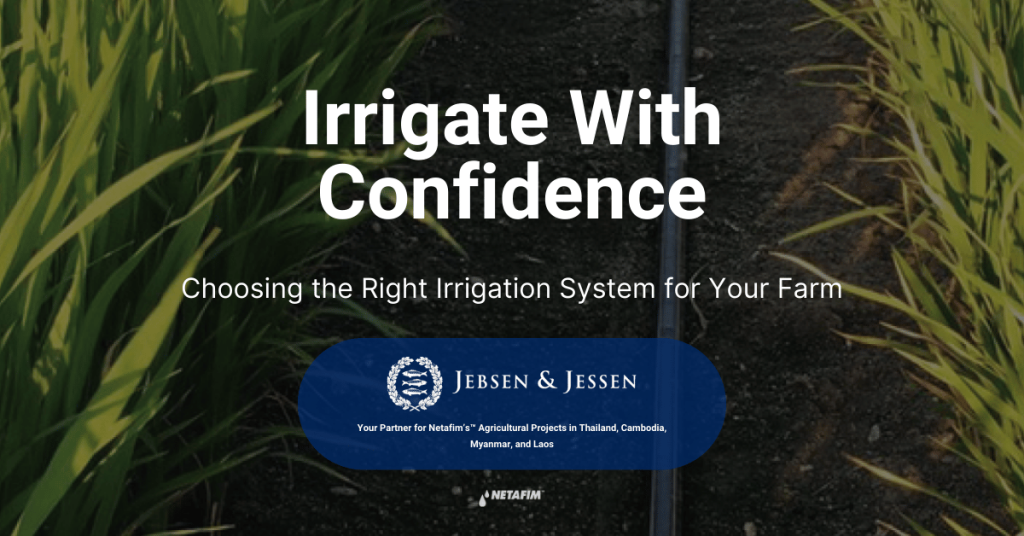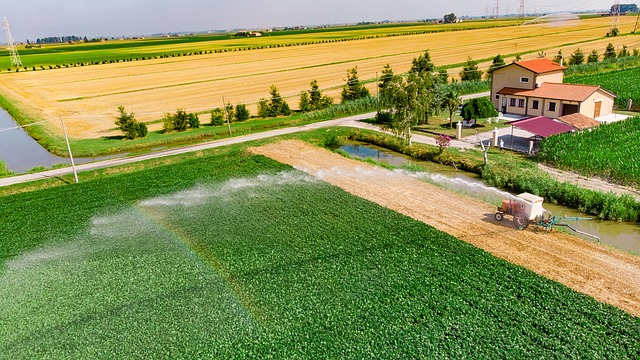Understanding the Southeast Asian Context
Regional Diversity
Agricultural landscapes in Southeast Asia are quite diversified, ranging from large rice paddies in Thailand to tropical fruit farms and palm oil plantations in Malaysia and Indonesia. So, choosing an irrigation system in Southeast Asia can be tricky as each region has its own specific practices and irrigation requirements.
- Rice Paddies: Rice is the staple crop in Thailand and usually requires flooded fields to grow it maximally. Surface irrigation systems are very common; however, because of increasing water conservation demands, choosing an efficient Southeast Asian system like drip irrigation is crucial.
- Fruit Farms: Fruit like durians, rambutans, and others in the tropics do best in well-drained soils. Drip irrigation is best because these crops require an exact water supply for consistent moisture level requirements.
- Palm Oil Plantations: Indonesia is the world’s largest palm oil producer; its plantations use extensive volumes of water for irrigation. Irrigation systems have to be designed to maximise productivity while limiting environmental damage.
Climate Considerations
The geography of the region, characterized by its tropical climate, is usually associated with high humidity and wet and dry seasons, where an important consequence can be noticed in irrigation systems. Monsoon yields average rainfall with a shortage of water during dry seasons.
- Monsoon Seasons: Excess water produced during the wet season needs to be managed to avoid flooding and loss of crops. On the contrary, water shortages caused during the dry season mean there is every need for the use of supplemental irrigation.
- Humidity and Temperature: In hot and humid weather conditions, evaporation may increase, making water-saving irrigation technologies crucial. Farmers should take into account how these climatic conditions dictate the methods of irrigation they will use.
Water Resource Management
Optimizing water use is crucial in Southeast Asia, considering the specific weather characteristics and the increasing demand for water resources. Many places have limited or unsteady rainfall patterns, which makes it impossible for the farmers to depend only on the rain. Using proper irrigation techniques can prevent water shortage even in situations with insufficient rain.
With the rapid urban expansion and rise of industry, the struggle for water intensifies. In response, farmers have to adopt irrigation practices that demand less water usage but provide high crop yields.
Factors to Consider When Choosing an Irrigation System in Southeast Asia
When choosing an irrigation system in Southeast Asia, several key factors must be considered to ensure that the chosen method aligns with the farm’s specific needs.Crop Type
Different crops have varying water requirements; understanding these needs is fundamental to selecting the right irrigation system. For example:
- Rice: This crop is most commonly cultivated with surface irrigation because of its need for sufficient moisture all the time. In some cases, for example, with hybrid rice varieties that are more efficient with water – more advanced systems like drip irrigation, in SouthEast Asian Nations can be beneficial.
- Tropical Fruits: Crops such as mangoes and pineapples usually need a precise water supply. Hence, drip irrigation is most appropriate. This method saves water while allowing plants to receive optimum moisture for good yields.
- Oil Palm: For oil palm cultivation, there is often significant water demand, especially in dry periods. For large areas, sprinkler systems in SouthEast Asian Nations, capable of covering big areas with water evenly, can be utilized so that the trees can be watered properly.
Soil Type
The type of soil on a farm significantly influences irrigation choices. Southeast Asia features a wide range of soil types, including sandy soils in coastal areas and clay soils in inland regions.
- Sandy Soils: These soils drain quickly and may require more frequent irrigation to maintain moisture levels. Drip irrigation in South-East Asian Nations can be particularly effective in sandy soils, as it delivers water directly to the root zone, minimizing evaporation.
- Clay Soils: Clay retains moisture well but can become waterlogged if over-irrigated. Surface irrigation methods may still be applicable, but careful management is required to prevent water accumulation and root rot.
Understanding the soil characteristics of your farm is essential for choosing an irrigation system in Southeast Asia that optimizes water use and promotes healthy crop growth.
Farm Size and Topography
The size and layout of a farm should be considered when choosing irrigation systems in Southeast Asia. Larger farms may require more extensive irrigation infrastructure, while smaller farms may benefit from simpler, more cost-effective solutions.
- Flat Terrain: Surface irrigation methods can be effective in flat areas, as water can flow evenly across the fields. However, farmers should consider the potential for waterlogging and ensure proper drainage.
- Hilly Regions: In areas with uneven terrain, drip irrigation or sprinkler systems in South-East Asian Nations may be more suitable. These systems can be designed to accommodate the topography, ensuring even water distribution and reducing runoff.
Local Infrastructure and Resources
The availability of local resources, including water supply, energy, and infrastructure, is a critical consideration when choosing irrigation systems in Southeast Asia.
- Water Supply: Farmers must assess the reliability and quality of their water sources. In some areas, groundwater may be the primary source, while in others, surface water may be more accessible. Understanding the water supply will help determine the most appropriate irrigation method.
- Energy Supply: Many modern irrigation systems, such as automated drip irrigation, require a reliable energy source. Farmers should consider the availability of electricity or alternative energy sources when selecting an irrigation system.
- Existing Infrastructure: The presence of existing irrigation infrastructure, such as canals or pumps, can influence the choice of system. Farmers may be able to retrofit or upgrade existing systems to improve efficiency.
Comparing Irrigation Methods for South-East Asian Nations Farms
Several irrigation methods are commonly used in Southeast Asia, each with its own advantages:Drip Irrigation
Drip irrigation in South-East Asian Nations is ideal for water conservation and precision, particularly in regions like Indonesia and Malaysia, where water management is crucial. This method delivers water directly to the roots of plants, minimizing evaporation and ensuring optimal plant growth.
Advantages
- Water Conservation: Drip systems minimize water wastage by delivering water directly to the root zone, reducing evaporation and runoff.
- Improved Crop Yields: Drip irrigation can enhance crop growth and yield by providing consistent moisture, particularly in regions with variable rainfall.
- Reduced Labor Costs: Automated drip systems can reduce the need for manual watering, saving time and labor costs for farmers.
Sprinkler Systems
Sprinkler systems are well-suited for Southeast Asia farming, where uniform water distribution is needed. These systems use a network of pipes and pumps to distribute water over a wide area, mimicking natural rainfall.
Advantages
- Even Coverage: Sprinkler systems in South-East Asian Nations can provide uniform water distribution, ensuring that all plants receive adequate moisture.
- Flexibility: Sprinklers can be adjusted to accommodate different crop types and growth stages, allowing farmers to tailor watering schedules to their specific needs.
- Reduced Soil Erosion: By distributing water gently, sprinkler systems can help reduce soil erosion compared to traditional surface irrigation methods.
Surface Irrigation
Surface irrigation is one of Southeast Asia’s oldest and most widely used methods. This technique involves flooding the fields with water, allowing it to flow across the surface and infiltrate the soil.
Advantages
- Simplicity: Surface irrigation systems are relatively simple to implement and require minimal investment.
- Cost-Effective: Surface irrigation may still be the most cost-effective solution for some traditional crops.
Disadvantages
- Water Waste: Surface irrigation can lead to significant water loss through evaporation and runoff, particularly in hot climates.
- Uneven Distribution: Water may not reach all field areas evenly, leading to under or over-watering of crops.
Subsurface Irrigation
Subsurface irrigation involves placing water delivery systems below the soil surface, delivering water directly to the root zone. This method is particularly effective in arid regions where evaporation rates are high.
Advantages
- Reduced Evaporation: As these subsurface systems deliver the water beneath the surface, there is very little loss through evaporation. Subsurface systems are thereby very suitable for extremely hot and dry climates.
- Improved Soil Moisture: Due to subsurface irrigation, the plants will have a consistent amount of soil moisture that will be helpful for their growth.
- Less Weed Growth: Subsurface irrigation reduces weed growth through the dry soil surface, hence minimizing the application of herbicides.
Netafim’s Advanced Irrigation Solutions for Southeast Asia
Netafim is a global leader in precision irrigation, offering farmers in Southeast Asia specifically tailored solutions to their needs. With a keen sense of innovation, its technologies aim to maximize water utilisation and encourage sustainable agricultural practices.Customized Solutions
The irrigation systems by Netafim come to address the needs of South-East Asian Nations farmers, whether for rice, fruits, or any other crop. That is why their products are designed to optimize water use and productivity to ensure farmers get the best possible results.Innovative Technology
Advanced technologies from Netafim, including automated systems and smart irrigation, help optimize water use in the climatic conditions of this region. The innovations enable monitoring of soil moisture levels, weather conditions, and crop water requirements, allowing accurate irrigation scheduling.Jebsen and Jessen (Turf & Irrigation) and Netafim Partnership
Localized Expertise
Being the official partner of Netafim Agricultural Projects in Thailand, Cambodia, Myanmar, and Laos, Jebsen and Jessen (Turf & Irrigation) offers expert knowledge and a deep understanding of the agricultural environment that exists in the area. Their group of professionals can offer customized advice and solutions since they are well-versed with the particular possibilities and problems encountered by farmers in Southeast Asia.Support and Training
Jebsen and Jessen (Turf & Irrigation) commits itself to seeing that the farmers of Southeast Asia get the highest returns from Netafim’s irrigation solutions. They offer in-depth training programs to ensure farmers operate and care for irrigation systems efficiently. The company also offers post-purchase support, which ensures farmers get relevant information long after purchase.Expanding Reach
Jebsen and Jessen (Turf & Irrigation) is expanding its scope in Southeast Asia; they tailor their offerings to meet the unique needs of every country. Close cooperation with nearby farms facilitates Jebsen and Jessen (Turf & Irrigation)’s progress towards sustainable agriculture and offers farmers tools that provide a proper basis for informed decisions regarding irrigation techniques.In Conclusion
For Southeast Asian farmers looking to optimize output, preserve water supplies, and guarantee the long-term viability of their farms, selecting the appropriate irrigation system is essential. Farmers may choose the best irrigation option for their needs by considering crop variety, soil conditions, and local infrastructure.
Southeast Asian farmers may contribute to sustainable agricultural practices, increase crop yields, and optimize water consumption by utilizing Jebsen and Jessen (Turf & Irrigation)’s knowledge and Netafim’s advanced irrigation systems. For professional guidance on selecting and putting Netafim irrigation systems into practice, contact Jebsen and Jessen (Turf & Irrigation). Explore more about the products and services offered by Jebsen and Jessen (Turf & Irrigation) and Netafim to help Southeast Asian farmers achieve productive and sustainable agricultural solutions.



